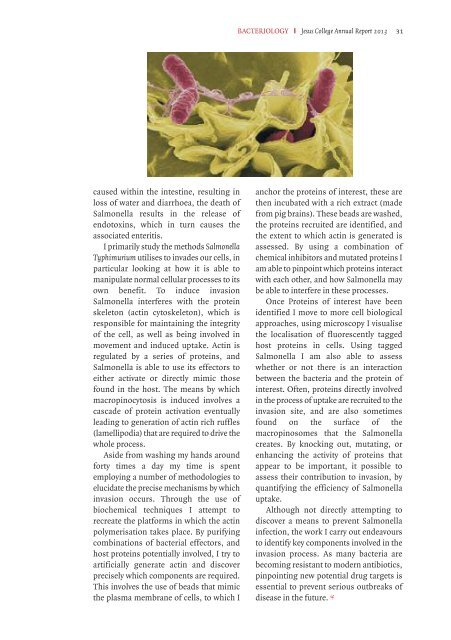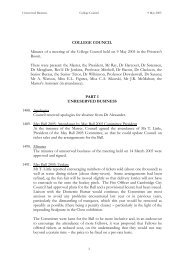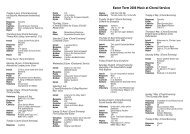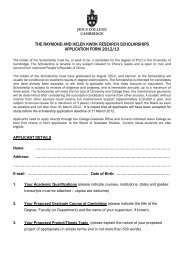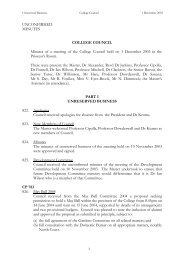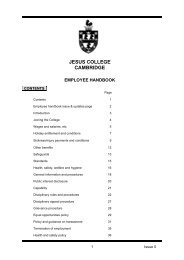2013 Annual Report - Jesus College - University of Cambridge
2013 Annual Report - Jesus College - University of Cambridge
2013 Annual Report - Jesus College - University of Cambridge
Create successful ePaper yourself
Turn your PDF publications into a flip-book with our unique Google optimized e-Paper software.
BACTERIOLOGY I <strong>Jesus</strong> <strong>College</strong> <strong>Annual</strong> <strong>Report</strong> <strong>2013</strong> 31<br />
caused within the intestine, resulting in<br />
loss <strong>of</strong> water and diarrhoea, the death <strong>of</strong><br />
Salmonella results in the release <strong>of</strong><br />
endotoxins, which in turn causes the<br />
associated enteritis.<br />
I primarily study the methods Salmonella<br />
Typhimurium utilises to invades our cells, in<br />
particular looking at how it is able to<br />
manipulate normal cellular processes to its<br />
own benefit. To induce invasion<br />
Salmonella interferes with the protein<br />
skeleton (actin cytoskeleton), which is<br />
responsible for maintaining the integrity<br />
<strong>of</strong> the cell, as well as being involved in<br />
movement and induced uptake. Actin is<br />
regulated by a series <strong>of</strong> proteins, and<br />
Salmonella is able to use its effectors to<br />
either activate or directly mimic those<br />
found in the host. The means by which<br />
macropinocytosis is induced involves a<br />
cascade <strong>of</strong> protein activation eventually<br />
leading to generation <strong>of</strong> actin rich ruffles<br />
(lamellipodia) that are required to drive the<br />
whole process.<br />
Aside from washing my hands around<br />
forty times a day my time is spent<br />
employing a number <strong>of</strong> methodologies to<br />
elucidate the precise mechanisms by which<br />
invasion occurs. Through the use <strong>of</strong><br />
biochemical techniques I attempt to<br />
recreate the platforms in which the actin<br />
polymerisation takes place. By purifying<br />
combinations <strong>of</strong> bacterial effectors, and<br />
host proteins potentially involved, I try to<br />
artificially generate actin and discover<br />
precisely which components are required.<br />
This involves the use <strong>of</strong> beads that mimic<br />
the plasma membrane <strong>of</strong> cells, to which I<br />
anchor the proteins <strong>of</strong> interest, these are<br />
then incubated with a rich extract (made<br />
from pig brains). These beads are washed,<br />
the proteins recruited are identified, and<br />
the extent to which actin is generated is<br />
assessed. By using a combination <strong>of</strong><br />
chemical inhibitors and mutated proteins I<br />
am able to pinpoint which proteins interact<br />
with each other, and how Salmonella may<br />
be able to interfere in these processes.<br />
Once Proteins <strong>of</strong> interest have been<br />
identified I move to more cell biological<br />
approaches, using microscopy I visualise<br />
the localisation <strong>of</strong> fluorescently tagged<br />
host proteins in cells. Using tagged<br />
Salmonella I am also able to assess<br />
whether or not there is an interaction<br />
between the bacteria and the protein <strong>of</strong><br />
interest. Often, proteins directly involved<br />
in the process <strong>of</strong> uptake are recruited to the<br />
invasion site, and are also sometimes<br />
found on the surface <strong>of</strong> the<br />
macropinosomes that the Salmonella<br />
creates. By knocking out, mutating, or<br />
enhancing the activity <strong>of</strong> proteins that<br />
appear to be important, it possible to<br />
assess their contribution to invasion, by<br />
quantifying the efficiency <strong>of</strong> Salmonella<br />
uptake.<br />
Although not directly attempting to<br />
discover a means to prevent Salmonella<br />
infection, the work I carry out endeavours<br />
to identify key components involved in the<br />
invasion process. As many bacteria are<br />
becoming resistant to modern antibiotics,<br />
pinpointing new potential drug targets is<br />
essential to prevent serious outbreaks <strong>of</strong><br />
disease in the future.


